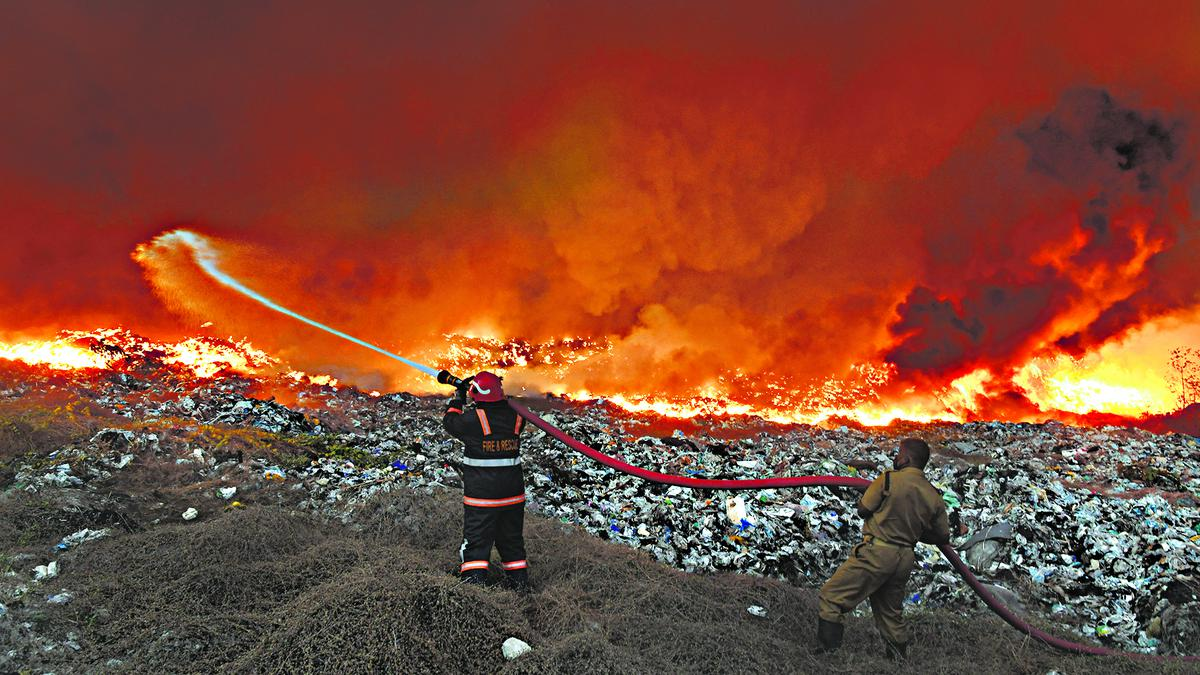22 Mar 2023 Landfill Fire
Landfill Fire
This article covers “Daily current events “and the topic is about ‘Landfill fire’ which is in news, it covers “Environment” In GS-3, the following content has relevance for UPSC.
For Prelims: Landfill Fire
For Mains: GS-3, Environment
Why in news: On March 2, the dumping yard caught fire. The garbage yard, which included a large amount of plastic waste, smoldered over the following 12 days, casting a noxious cloud over Kerala’s commercial city.
About landfill
- A landfill also known as a tip, dump, rubbish dump, garbage dump, or dumping ground, is a location where waste items are disposed of.
Types of landfill
- Municipal Solid Waste Landfills (MSWLFs): Specifically designed to manage domestic rubbish and other non-hazardous waste.
- Bioreactor Landfills: A type of MSWLF that converts and decomposes organic waste fast.
- Industrial Waste Landfills: Designed to collect commercial and institutional rubbish (also known as industrial waste), which accounts for a significant volume of solid waste even in small towns and cities.
- Construction and Demolition (C&D) Debris Landfills: C&D materials frequently incorporate bulky, heavy materials such as concrete, wood, metals, glass, and salvaged building components.
- Coal Combustion Residual (CCR) landfills: A landfill for industrial trash used to manage and dispose of residuals from coal combustion (CCRs or coal ash).
- Hazardous Waste Landfills: Hazardous waste disposal facilities.
Causes of landfills fire
- Waste containing flammable materials: Combustible materials, such as low-quality plastics, can be found in openly discarded garbage and have a greater calorific value of roughly 2,500-3,000 kcal/kg.
- Summer is dry and hot: The biodegradable component composts much faster, boosting the heap temperature to 70-80° C.
- Low efficiency in waste processing: Municipalities in India gather more than 95% of urban waste, yet waste processing efficiency is about 30-40%.
- Poor segregation of waste at source: Municipalities are expected to segregate their wet and dry garbage and recycle the recovered byproducts.
- Massive amounts of unprocessed trash: Remains in open landfills for long periods.

Landfill Fire
Impacts of landfill fire
- Greenhouse gases: Landfill fires release greenhouse gases, which harm the ecosystem.
- Schools Education System: This affects the education system since the landfill fire forces the closure of surrounding schools.
- Carcinogens -The waste may contain carcinogen materials which increase the chances of being affected by the cancer-causing disease.
Measures to combat landfill fire
- Precautionary Measures:
- For immediate intervention, water tankers equipped with sprinklers should be stationed at the waste site.
- The municipality should work with the local fire service to develop a plan of action ahead of time.
- Waste-processing workers (plant operators, segregation, and so on) should have basic fire safety and response training.
- The municipality should have video surveillance of the landfill’s most combustible section around the clock.
- Short-Term Measures:
- The first immediate step is to divide a site into blocks based on the type of garbage.
- Bricks that have been capped with dirt are less prone to catch fire, therefore these should be separated as well.
- To encourage individuals to stay indoors.
- People are given N95 masks.
- Long-Term / Permanent Solutions:
- Bioremediation can be used to remove trash piles.
- Biomining should be implemented for waste disposal that is both safe and low-cost.
- Cover the entire site with soil.
Government measures for solid waste management
- Solid Waste Management Rules (SWM), 2016: The new regulations mandate waste segregation at the source to redirect waste to wealth through recovery, reuse, and recycling. Before handing over waste to the collector, waste generators must now separate waste into three streams: biodegradables, dry (Plastic, Paper, Metal, Wood, etc.), and domestic hazardous waste (diapers, napkins, insect repellants, cleaning agents, etc.).
- Pollution Control Boards: The Pollution Control Boards are ordered to take measures to persuade local authorities of the importance of proper municipal solid waste management.
Waste Disposal Challenges faced by Municipal Corporations
- Inadequate funding
- The communication gap between central and state governments.
- Waste-to-energy initiatives are struggling.
- Municipal organizations have flaws at every stage of garbage management.
- Inadequate manpower
- Inadequate amount of waste management technology personnel.
- Absence of new technological techniques, research, and developments.
- Absence of public cooperation in waste sorting at the source.
Way forward
- The permanent and necessary solution is to ensure that cities have a systematic waste-processing system in place where moist and dry trash is processed separately and their byproducts are appropriately disposed of (recycling, soil enrichment, etc.). Many parties, including municipalities and waste-processing unit operators, will need to work together to achieve this.
- Given that India’s summer has already begun, towns must take immediate steps to prevent fires while simultaneously concentrating on long-term solutions to enhance solid waste management.
Source:
Get daily current affairs from Yojna IAS


No Comments